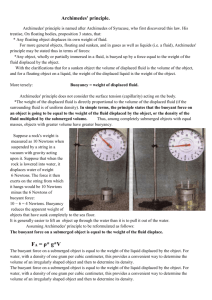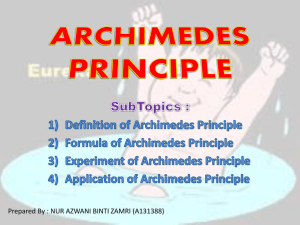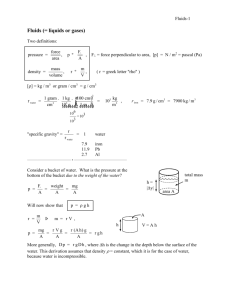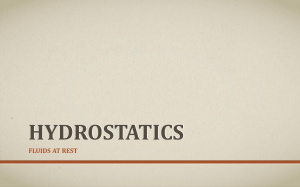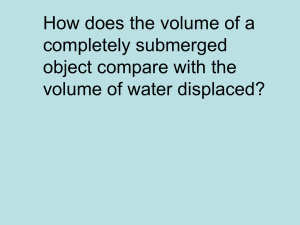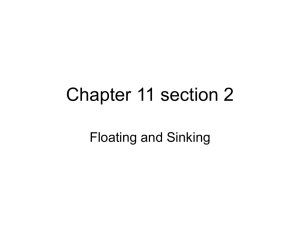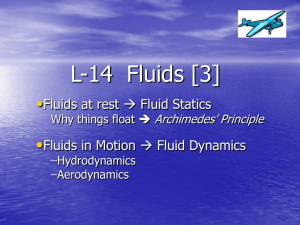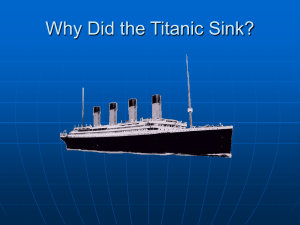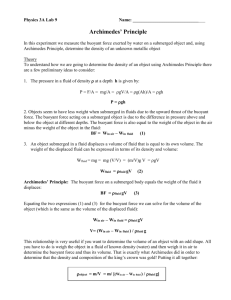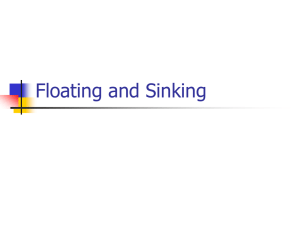- U
advertisement
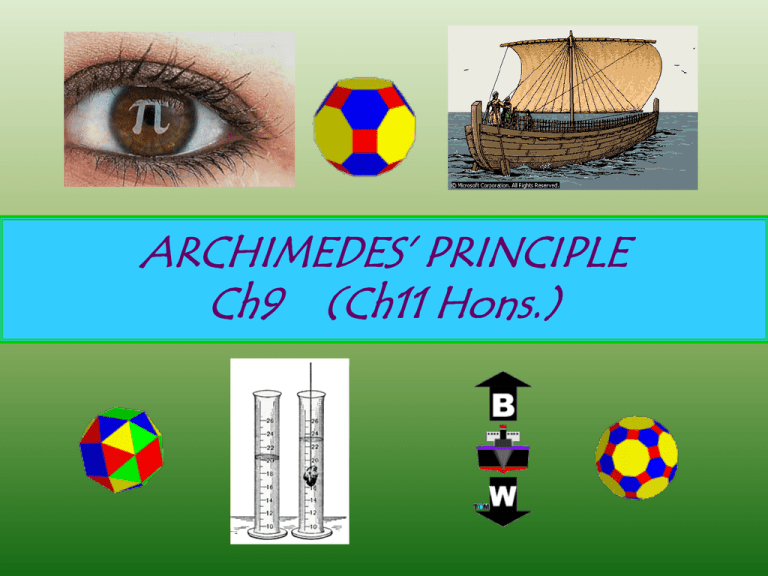
ARCHIMEDES’ PRINCIPLE Ch9 (Ch11 Hons.) Pressure • • • • Pressure = Force (N) / Area (m2) Unit is pascal (Pa) which is VERY small. Also use atm, or psi (pounds/inch2) Pressure is useful as it expresses the strength of materials (Ex. a container can withstand 150 psi. • As usual, knowing two variables allows you to calculate the third. ( P = F/a ) Pressure at depth • FLUID – a liquid or a gas. • Pressure is higher:lower at the bottom of a fluid. P = P0 + ρ g h Where P0 is atmospheric pressure P is pressure at depth, ρ is density of fluid, g is acc. Due to gravity h is the height below the fluid top surface Who is Archimedes? • Archimedes (287-212 BC), pre-eminent Greek mathematician and inventor, who wrote important works on plane and solid geometry, arithmetic, and mechanics. Reason for buoyant force…. The law • Archimedes' Principle, states that when an object is totally or partially immersed in a fluid, it experiences an upward buoyant force equal to the weight of the fluid displaced. The principle is most frequently applied to the behaviour of objects in water, and helps to explain floating and sinking, and why objects seem lighter in water. It also applies to balloons in the air. UPTHRUST AND BUOYANT FORCE The key word in the principle is “upthrust” (or buoyant force), which refers to the force acting upward to reduce the apparent weight of the object when it is in the water or under water. for example, a metal block with a volume of 100 cm3 is dipped in water, it displaces an equal volume of water, which has a weight of approximately 1 N. The block therefore seems to weigh about 1 N less. SINKING AND FLOATING OBJECTS The reading of spring balance is 2.7 N The reading of spring balance is 1.7 N What is the reading of spring balance if the wood is attached to it ? ZERO Density and Buoyancy From Archimedes’s Principle : Buoyant Force = Weight of fluid displaced = mg (note : F = ma) = Vg (note : = m ) V Thus FB = V g Where …… FB = Buoyant Force or Upthrust = Density of fluid V = Volume of fluid displaced or the volume of the object if it is totally submerged in the fluid. Buoyant Force and Flotation Buoyant force = weight the object floats and stationary Buoyant force > weight the object moves up Buoyant force < weight the object moves down The Law of Flotation A floating object displaces its own weight of fluid in which it floats. THINK!!!!! warm fresh water cold fresh water warm sea water cold sea water 1. Why the depth of ship immersed in the water different? Fresh water less dense than sea water and warm water less dense than coldwater so warm fresh water need to be displaced more to keep the uptrust force equal with weight of the boat so it still can float. 2. If the modeling clay is formed into a ball, it will sink. But when it is formed into a hull it will float. Why? - BECAUSE….. APPLICATIONS Hot air balloon 1. rises upwards (Upthrust > Weight of hot air (helium gas) + weight of airship fabric + weight of gondola + weight of passengers.)( balloon expand) 2..descends (Upthrust < Weight of hot air (helium gas) + weight of airship fabric + weight of gondola + weight of passengers.)(balloon shrinks) 3. stationary (Upthrust = Weight of hot air (helium gas) + weight of airship fabric + weight of gondola + weight of passengers.)( balloon size uncanged) PLIMSOLL LINE OF THE SHIP The density of sea water varies with location and season. To ensure that a ship is loaded within safe limits , the Plimsoll line marked on the body of the ship acts as a guide. If ballast tanks empty Upthrust > weight submarine rises to surface If ballast tanks full Upthrust < weight submarine sinks to bottom SUBMARINE Hydrometer An hydrometer is an instrument used to measure the density of a liquid. lead shot to make it float upright In a liquid of lesser density , the hydrometer is more submerged. The hydrometer floats higher in a liquid of higher density. Archimedes Principle problems • Use fact that weight of displaced fluid = Fb • Remember ρ = m / V • Fg (object) / Fb = ρo / ρ f • Where Fg (object) is weight of object (or weight in air) • Fb is buoyant force • ρ is density (of object or fluid) Example 1. The weight of the rock in air is 0.85N. When it is completely submerged in water, its weight is 0.45N. What is the buoyant force acting on the rock when it is completely submerged in the water ? Solution : Buoyant force = Actual weight – Apparent weight = 0.85 – 0.45 = 0.4N or 0.4 kg m/s2 2. A concrete slab weight 180N. When it is fully submerged under the sea its apparent weight is 105N. Calculate the density of the sea water if the volume of the sea water displaced by the concrete slab is 4800 cm3. [ g = 9.8 m/s2 ] Solution : Buoyant force = actual weight – apparent weight = 180 – 105 = 75N According to Archimedes’s principle Buoyant force = weight of sea water displaced Therefore, F = ρVg so…. ρ = F / Vg = 75kg m/s2 / (4800 x 10-6 m2 x 9.8m/s2 ) = 1530.61 kg / m-3 Example A rectangular ferry boat is 15m long by 6m wide. A 2500kg truck drives onto the ferry. If the density of water is 1000kg/m3 . Find out how far down the hull of the ferry sinks. Δ Fb = Δ weight of water displaced. mt g = Vw ρw g mt = Vw ρw = (l w h) ρw , we need to solve h h = mt / l w ρw = 2500kg/ 15m 6m 1000kg/m3 = Homework Regular: P343 Concepts Q1-7 Write out in full sentences. You must read the section on Archimedes principle and use the ideas within. Honors: Question 11 – 17 P352 (Concepts) 2nd day homework HONORS: P 353 Q2 (8300Lb), 5 (317m2) (density), 10 (1.3 million lb),12 (32N),13 (4.76 X104),14 (24) (pressure), 19 (1.26x 105Pa), 21 (3.5x 106 N), 23 (1.2X10 5 Pa) (pressure with depth) Regular : P327 Q 2 (2.7X102), 3 (1.2X10 3 Pa, 6.0 X10 -2 N . P330 Q1 (1.11X108 Pa), 2 (8.25X10 5 Pa), 3 (2.7X10 4 Pa) , 4 (1.03 X105 Pa, 1.05X105 Pa). P331 Q1,2,3,4 Pascal’s principle Honors P329 , reg. P326 Any change in pressure in an enclosed, static fluid is transmitted equally to all parts of the fluid and the container walls. What does static mean? Examples of Pascal’s principle include a hydraulic car jack, a hydraulic ram etc. – P1 P2 Ex: car jack has small piston area = 1.0 X10-6 m2 and a large piston of 0.50 X10-4 m2. – How much can it lift if the small piston is pushed down with a force of 180N? – Given: Pascal says P1 = P2 ,So F1 / A1 = F2 / A2 – Rearrange to get F2 on its own F2 = A2 F1 / A1 – So substitute to solve…. – Tonight for homework do P Important general rule….. Fluids flow from areas of ______ pressure to areas of ____ pressure. Pressure in a fluid at any point pushes equally in all directions Bernoulli’s Principle Daniel Bernoulli (Swiss) in the early 1700’s observed that air and other fluids do not behave as one would expect. Specifically: “A fluid moving at a high velocity exhibits ____ pressure . A fluid moving at a low velocity exhibits ____ pressure.” This principle explains many phenomena: Being pushed into path of speeding vehicle, a carburetor and many more….. Shower curtain pushed in House roof coming off in tornado Curve balls in any ball sport Lift from an airfoil (wing) Where to find Bernoulli’s Principle in your book.. Honors: P 343- P344 Regular : P335
